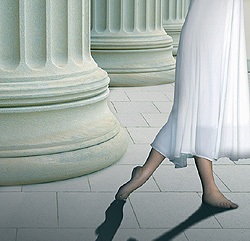Mt. Airy’s Allens Lane Arts Center is closing out their current theatrical season with WHEN SHE DANCED by Martin Sherman. Directed by Maurizio Giammarco, the play deals with the later life of iconic dancer Isadora Duncan, and will run in the Center’s cabaret style theatre from May 2nd to the 16th.
Angela Isadora Duncan was born in California in 1877, the daughter of banker and arts connoisseur Joseph Charles Duncan. She was the youngest of four children, two brothers: Augustin (an actor) and Raymond (an artist), and a sister, Elizabeth—also a dancer. Shortly after Isadora’s birth, unfortunately, Joseph Duncan lost the bank; he was publicly disgraced and the family fell on hard times financially. Following her parents’ divorce, Isadora’s mother and siblings moved to Oakland, CA, where her mother worked as a pianist and music teacher. Feeling stifled by the regulations, Isadora dropped out of school at an early age; she and her sister gave dance lessons to young girls to help support the family. Even at this early stage, her approach to dance was unconventional—she preferred to improvise movements as the music moved her. In her teens she became restless and wanted to travel; she soon arrived in Chicago where she auditioned for a number of theatre companies, finally securing a spot with Augustin Daly’s group. Duncan travelled to New York City with Daly’s group, but unique approach to dance clashed with the conventions of the day. Feeling stifled in the US, Isadora moved to London in 1898; she soon found work dancing in the drawing rooms of the wealthy. These engagements enabled her to start her first dance studio.
Soon Duncan was in Paris, where she opened another studio and began touring Europe. The outbreak of World War I brought her back to New York, and she started becoming more politically active shortly thereafter. In 1921, her leftist sympathies took her to the Soviet Union where she founded a school in Moscow. Her support of the Soviets would lead to her being banned from the US.
Sherman’s play deals with the later part of her life in exile; WHEN SHE DANCED examines her relationship with Russian poet Sergei Yesenin, whom she married in 1922. Duncan was considerably older and things between the two were quite volatile. The story covers one particular day in 1923 when Isadora is trying to figure out how to get money to return to Russia. But Sherman can’t seem to decide if he’s written a farce or a drama.
I happen to love plays that walk that tightrope between making me laugh and making me cry—that’s life. And some playwrights are wonderful at creating that balance; I don’t think Sherman is one of them. To me, the script is very unfocused. Add the fact that one character speaks only Russian, one only French, another only Swedish and a fourth only Italian. It was hard to feel vested in these characters. The cast, led by Susan Chase as Isadora, was credible, the accents believable…but I just couldn’t care.
The tech work by Giammarco (set), Mike Lucek (lights) and Browning Sterner (sound) was well done, as was David Ward’s build. The remainder of the cast (Thomas Braun, Susan Mattson, Elliott Rotman, Kathleen Sink, Sharon Sigal, Glenn Kraft, Heloise Wilson and Abdel Pena) are decent actors who made the best of the material. Giammarco’s direction was relatively well executed, but the story was such a mish-mash. I kept wishing for more. I don’t know what of, but I knew this wasn’t really going anywhere. This is just my reaction to what I viewed, I’m always open to hearing other people’s impressions of the work…
WHEN SHE DANCED
by Martin Sherman
Directed by Maurizio Giammarco
May 2—16, 2014
Allen’s Lane Center for the Arts
Allen’s Lane & McCallum Streets
Philadelphia, PA 19119
215-248-0546
www.allenslane.org


